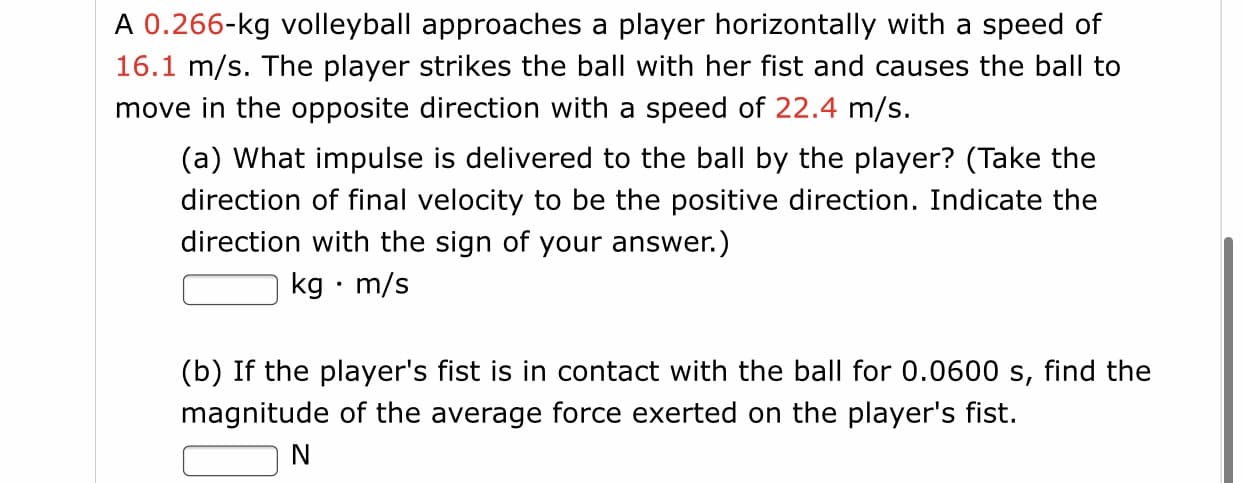A 0.266-kg volleyball approaches a player horizontally with a speed of 16.1 m/s. The player strikes the ball with her fist and causes the ball to move in the opposite direction with a speed of 22.4 m/s. (a) What impulse is delivered to the ball by the player? (Take the direction of final velocity to be the positive direction. Indicate the direction with the sign of your answer.) kg • m/s (b) If the player's fist is in contact with the ball for 0.0600 s, find the magnitude of the average force exerted on the player's fist. N
A 0.266-kg volleyball approaches a player horizontally with a speed of 16.1 m/s. The player strikes the ball with her fist and causes the ball to move in the opposite direction with a speed of 22.4 m/s. (a) What impulse is delivered to the ball by the player? (Take the direction of final velocity to be the positive direction. Indicate the direction with the sign of your answer.) kg • m/s (b) If the player's fist is in contact with the ball for 0.0600 s, find the magnitude of the average force exerted on the player's fist. N
Classical Dynamics of Particles and Systems
5th Edition
ISBN:9780534408961
Author:Stephen T. Thornton, Jerry B. Marion
Publisher:Stephen T. Thornton, Jerry B. Marion
Chapter9: Dynamics Of A System Of Particles
Section: Chapter Questions
Problem 9.30P
Related questions
Question

Transcribed Image Text:A 0.266-kg volleyball approaches a player horizontally with a speed of
16.1 m/s. The player strikes the ball with her fist and causes the ball to
move in the opposite direction with a speed of 22.4 m/s.
(a) What impulse is delivered to the ball by the player? (Take the
direction of final velocity to be the positive direction. Indicate the
direction with the sign of your answer.)
kg • m/s
(b) If the player's fist is in contact with the ball for 0.0600 s, find the
magnitude of the average force exerted on the player's fist.
N
Expert Solution
This question has been solved!
Explore an expertly crafted, step-by-step solution for a thorough understanding of key concepts.
This is a popular solution!
Trending now
This is a popular solution!
Step by step
Solved in 2 steps with 2 images

Knowledge Booster
Learn more about
Need a deep-dive on the concept behind this application? Look no further. Learn more about this topic, physics and related others by exploring similar questions and additional content below.Recommended textbooks for you

Classical Dynamics of Particles and Systems
Physics
ISBN:
9780534408961
Author:
Stephen T. Thornton, Jerry B. Marion
Publisher:
Cengage Learning

Physics for Scientists and Engineers with Modern …
Physics
ISBN:
9781337553292
Author:
Raymond A. Serway, John W. Jewett
Publisher:
Cengage Learning

Principles of Physics: A Calculus-Based Text
Physics
ISBN:
9781133104261
Author:
Raymond A. Serway, John W. Jewett
Publisher:
Cengage Learning

Classical Dynamics of Particles and Systems
Physics
ISBN:
9780534408961
Author:
Stephen T. Thornton, Jerry B. Marion
Publisher:
Cengage Learning

Physics for Scientists and Engineers with Modern …
Physics
ISBN:
9781337553292
Author:
Raymond A. Serway, John W. Jewett
Publisher:
Cengage Learning

Principles of Physics: A Calculus-Based Text
Physics
ISBN:
9781133104261
Author:
Raymond A. Serway, John W. Jewett
Publisher:
Cengage Learning

College Physics
Physics
ISBN:
9781285737027
Author:
Raymond A. Serway, Chris Vuille
Publisher:
Cengage Learning

College Physics
Physics
ISBN:
9781305952300
Author:
Raymond A. Serway, Chris Vuille
Publisher:
Cengage Learning

Physics for Scientists and Engineers: Foundations…
Physics
ISBN:
9781133939146
Author:
Katz, Debora M.
Publisher:
Cengage Learning